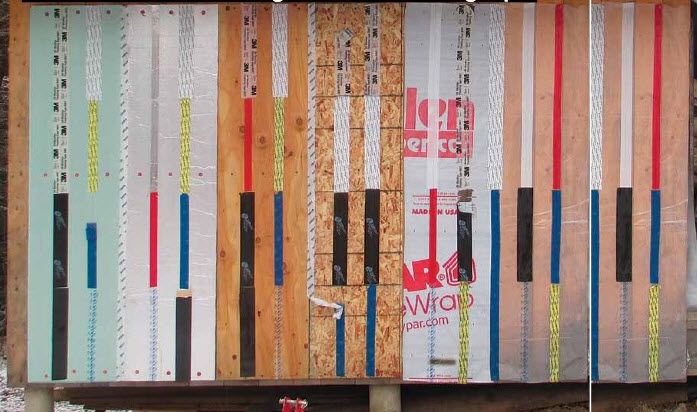
Some builders worry that air-sealing tapes won’t stand the test of time
Bill L is planning a new house in Massachusetts and seems stuck on an important construction detail, the building envelope’s air barrier. A key consideration is durability. Bill hopes the house will last a century or more, and he’s not convinced that either caulk or specialized construction tapes used to seal cracks and seams will last that long.
Not so, Bill is told. “Tape gets a bad rap from the products that were never intended to be used as an air barrier,” one poster writes. While solvent-based adhesives lose their grip over time, the acrylic adhesives used in high quality air-sealing tapes do not.
And besides, adds FHB senior editor Martin Holladay, there’s no guarantee the air-sealing membranes that come on a roll will last any longer than tape. The only way to be certain a building material will last 50 or 100 years, he adds, is to use one that’s been around that long and has proven itself.
That discussion is the topic for this Q&A Spotlight.
Fine Homebuilding Recommended Products
Fine Homebuilding receives a commission for items purchased through links on this site, including Amazon Associates and other affiliate advertising programs.

Reliable Crimp Connectors

Affordable IR Camera

Handy Heat Gun



























View Comments
I guess this post is really going to help all those who were looking forward to use air-sealing tapes. I found the post really informative and interesting to read and hope the others also do the same.
Martin Holladay suggests finding a material or building detail that has been around for 50 or 100 years and using that? We frequently remodel 100 year or older houses on the North Shore in Vancouver, BC, a notoriously wet climate and by that measure the most robust building detail is 3/4" horizontal planks and 30# builders felt. We just pulled off the original shingles of a house built in 1911 and the paper was still supple and flexible and no rot on the sheathing planks.
One caveat though... not one bat or scrap of any kind of insulation in the wall cavities either. So the house breathes nicely enough to dry out the sheathing and building wrap but the heating and AC bills literally suck; the money out of your client's wallets.
Next idea??
Martin Holladay suggests finding a material or building detail that has been around for 50 or 100 years and using that? We frequently remodel 100 year or older houses on the North Shore in Vancouver, BC, a notoriously wet climate and by that measure the most robust building detail is 3/4" horizontal planks and 30# builders felt. We just pulled off the original shingles of a house built in 1911 and the paper was still supple and flexible and no rot on the sheathing planks. One caveat though... not one bat or scrap of any kind of insulation in the wall cavities either. So the house breathes nicely enough to dry out the sheathing and building wrap but the heating and AC bills literally suck; the money out of your client's wallets.
Next idea??
About the suggestion of finding a material or building detail that has been around for 50 or 100 years and using that? By that measure the most robust building detail is 3/4" horizontal planks and 30# builders felt. We just pulled off the original shingles of a house built in 1911 and the paper was still supple and flexible and no rot on the sheathing planks. One caveat though... not one bat or scrap of any kind of insulation in the wall cavities either. So the house breathes nicely enough to dry out the sheathing and building wrap but the heating and AC bills literally suck; the money out of your client's wallets.
Next idea??
About the suggestion of finding a material or building detail that has been around for 50 or 100 years and using that? By that measure the most robust building detail is 3/4" horizontal planks and 30# builders felt. We just pulled off the original shingles of a house built in 1911 and the paper was still supple and flexible and no rot on the sheathing planks. One caveat though... not one bat or scrap of any kind of insulation in the wall cavities either. So the house breathes nicely enough to dry out the sheathing and building wrap but the heating and AC bills literally suck.
I think Martin's comment that the only way you can be sure that something will last 100 years is if has been demonstrated to last 100 years...and even then, the conditions have to be similar. It's one of the reasons I recommend cellulose as insulation. I lived through foam 1.0 in the 70's (that's 1970's, I should add) and it was a nightmare. I think we learned a lot and I think this generation of foam will last 50 years, but I don't know. Maybe it will last 100 years, but I wouldn't bet the bank on it.
The same is true for Tyvek. I know how long tar paper lasts and I know that Tyvek does a better job. Initially. My gut tells me that Tyvek will last longer and be effective longer...but that's because I've seen it hold up to years of being exposed directly to the weather (up here we refer to it as North Country siding). By the same token, I'm getting a chance to see how foil faced isocyanurate foam holds up, too, as it's another form of North Country siding.
Only time will tell for sure!
Of course tape is not going to last. Only a young person would expect it to. :-)
I understand that long exposure to ultra violet kills Tyvek and thereafter it doesn't perform as intended.